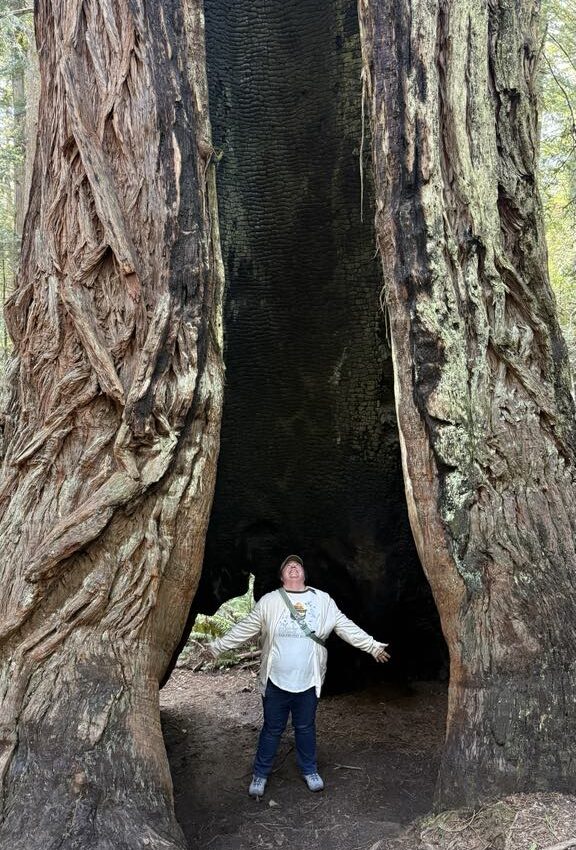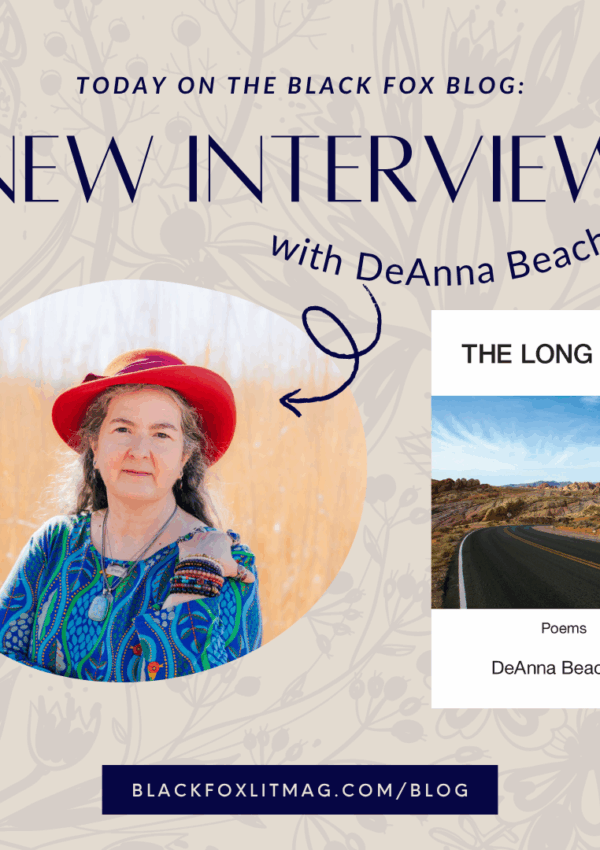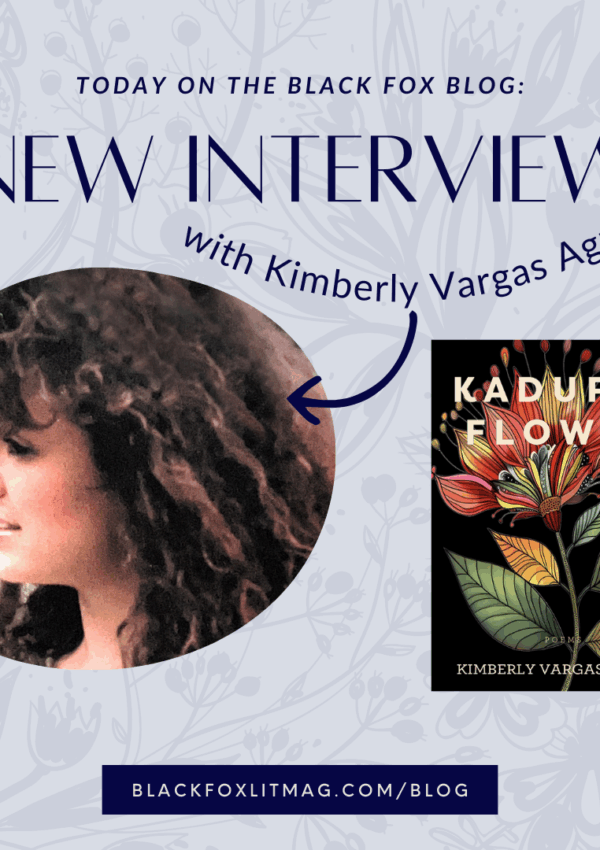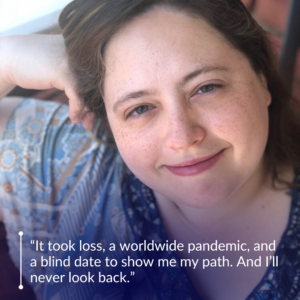Vanessa Couto Johnson (she/they) is the author of the full-length poetry books pH of Au (Parlor Press, Free Verse Editions Series 2022) and pungent dins concentric (Tolsun Books, 2018), as well as three poetry chapbooks. Most recently, Vanessa’s poems have appeared or are forthcoming in The Shore, Red Tree Review, Rogue Agent, and Broken Lens Journal, among others. A Brazilian who was born in Texas
(a dual citizen), VCJ teaches at Texas State University.
Heather Lang-Cassera: Having had the honor of publishing a previous collection of yours, back in 2018 with Tolsun Books, I was beyond thrilled to learn about your newest poetry title, pH of Au, released by Parlor Press earlier this year. Vanessa, congratulations! Your new collection is breathtaking.
I’d like to begin our conversation by chatting a bit about your title, pH of Au. This title grounds me, reminds me that beauty, such as that of gold, is ultimately inseparable from science. This established tone demands a gravid approach from me as a reader. I ponder the unavoidable nature of facts and realities in a way that makes the entire book, including the opening poem, “No drowning,” all the more palpable. The poem’s closing lines, “All night long / I don’t cup my hands with water,” give me chills while also cuing my messy heart-brain to think about how we are, in part, defined by absence, by figurative and literal negative space—another element of poetic craft at which you demonstrate incredible excellence. Before I get ahead of myself, though, might you please tell us a bit about your title?
Vanessa Couto Johnson: Thank you so much, Heather! Yes, titling this work pH of Au has felt like a risk in how science-forward of a phrasing it is for a poetry collection! Meanwhile, the words are of two letters each and soft words (not difficult to pronounce/lengthy jargon)—even, dare I say, international in the way scientific language seeks to be (the “of” the exception of course, conveying the collection is in English as its primary language). With “pH” being a scale, my hope is to convey a spectrum; while science does have quantitative answers for what the pH of gold is, I wanted to approach gold in a range of ways.
Getting into “No drowning,” I think of this as including a subtle/metaphorical “a-Narcissus” reimagining (adding the a- prefix here to mean without the inclinations to the turning points that would lead to Narcissus’s obsession and death): “Echo” tucked mid-line; there are mirrors and water, but these are avoided by the speaker. In terms of my real life, I was studying abroad (based in Berlin) in autumn 2008, and when I was visiting Versailles, I took pictures of the more ‘unsightly’ things that felt more intriguing to me than the ‘beauty’ (I actually don’t know what happened to these photos); in summer 2009, I returned to Brazil (the last visit in which both my grandparents would be alive).
HLC: Your mention of personal and family histories reminds me of questions I had during my first reading of the book, ones about the additional, further-back histories that pH of Au spans. In “Brasil & broil,” we read about the fire in the Museu Nacional in Rio de Janeiro, of how “A firefighter’s hands // burned in want to save Luzia’s bones, / 11,500 years beloved.” In “Near Igreja de São Domingos, Lisbon,” we read of someone who “draws // a cathedral where in 1506 // one said he saw Christ’s face and / another said it was a flame’s // reflection on a crucifix.” In “Libertas Quae Sera Tamen,” we read of Joaquim José da Silva Xavier, of how in the 1780s there is “Independence / over there. And there. But not Brazil.”
Vanessa, your collection feels deliberate in its exploration of the distant past. Also, you navigate between past and present seamlessly, exquisitely. Might you talk a bit about what drew you to reach back the distances you’ve reached? Additionally, did you encounter any challenges in the writing or revisions processes in regards to the management of centuries of historical events?
VCJ: I’ve wanted to learn more about Brazilian history; since I was educated in the U.S. and not formally taught about it, I’ve looked up some details myself. Of course, plenty more for me to learn!
One of the dimensions of place is the history of a place, as much as that can be accessible to those in the present; there are some places where history is preserved and recounted regularly (such as that Igreja de São Domingos, where a tour guide taught me those details) and somewhere artifacts can sadly become lost (as in a museum fire…). I hoped to incorporate this history dimension as much as I could.
Some of these history-incorporating poems have a first-person speaker that connects to the primary speaker of the book, like in “Brasil & broil,” while the middle section of the book (called “Hylozoism”) particularly has some poems in third person focused on the historical information (I would say I chose third person for information that I feel like an observer of but not a participant in: happenings in the past that I have not even visited the site[s] of). Hylozoism has the idea that all matter has life, which I wanted to explore through these poems, particularly thinking on how if matter (such as gold) were alive, what memories would it be able to recount?
On this thread of history, chemistry itself is, in a sense, without past: as a science, its repeatability and consistency have constants! But of course, if we think of chemistry in the anthropological sense of how humans worked up to it, we have alchemy, so I worked in alchemical themes to express a history of chemistry and human inclinations (and what inclinations the matter messed with would have as well).
When drafting, I was nervous if the history-focused poems would be ‘too enclosed’ or uninteresting to non-Brazilians, and I think working in the hylozoism and alchemical themes helped yield connections. I also think moving around in recent history and Brazilian colonial history without being strictly chronological helped indicate connections.
HLC: Vanessa, what you’ve mentioned about chemistry is fascinating! I’ve never thought about its pastless qualities before, at least not in this way. I appreciate your exploration of the second section’s title, “Hylozoism.” I notice the first section is “Chrysocyon,” and the third, and final, is “Kintsugi.” Might you share with us a bit about how you chose these headers, how you decided which poems should be placed where, and how you organized the book as a whole?
VCJ: If I may share a 200ish-word synopsis version first, here:
pH of Au is a litmus of perspective, even at long distance. While a partnership achieves a long-distance status, the speaker’s status as a citizen of a country where she does not currently live is itself a lifelong long-distance relationship. The first third of the book is called “Chrysocyon” (“golden dog,” genus of the South American maned wolf); the speaker accumulates anxieties of the upcoming separation but a doggedness to do what is best. The middle third is an intermission into alchemy (what can a “Modern alchemist’s autocomplete” and other chemistries offer) and into further deep griefs ranging from recent ecological harms to gold-rush, colonial Brazil. This section is titled “Hylozoism,” as if the matter is alive, is a witness to and reactive agent toward humanity. The final third of pH of Au works toward “Kintsugi”: while the opening poem of the book has cracks as photographic subject, here, habits of reconnecting and acknowledging space and how to fill it become not only responsibilities, but opportunities. The speaker is a dual citizen (can’t put a foot in both lands at once but is a dual citizen nonetheless) and is in a relationship with a partner hundreds of miles away; we retain identities even when outside the observable context that yielded them.
I have poems in this book written as far back as 2010 (the “No drowning” poem) and as recently as 2022 (“solanum lycocarpum”); several that are in the “Hylozoism” section were written in 2015, and most poems in the other sections were written from 2016-2019.
At one point, I was considering having a section called “Bromide’s Touch”: a slight pun on “Midas Touch” that would also reference the “trite remarks” meaning of “bromides,” while also bridging the chemistry meaning. I was planning for this section to have every poem title be constructed like “the ph___ wants an au___” (a word beginning with “ph” and a word beginning with “au” there); I wrote out a list of such word possibilities. Ultimately, I only wrote two of these: “the photoreconnaissance wants an autogiro” and “the phenetics wants an autograph” (which has the “Bromide’s touch” phrase tucked into it; I decided these two poems would satisfy my own want!).
I thought the Chrysocyon brachyurus to be an intriguing animal: despite being called a “maned wolf”/ “lobo-guará” the species is not actually a wolf; the “Chryso-” portion means “golden” in its Greek-based scientific name. I thought having my first section be named for this animal would acknowledge my South American roots and the natural world while working in the gold theme (and as I say above, a “doggedness” in my speaker).
Rounding out the book with “Kintsugi,” I thought, would bring in a header with a human touch that heals/repairs with gold (thus contrasting/transitioning from earlier parts of my book that think on the harms that have come through human wants of the metal). While my book does not directly speak on this, Brazil has the largest Japanese population outside of Japan.
HLC: Because my life is steeped in both ceramics and poetry, I can’t help but contemplate the ways in which kintsugi, as the art of repairing broken pottery, might be something like assembling phrases of poetry with enjambment, stanza breaks, and other negative space. Also, because your previous book, pungent dins concentric, was prose poetry, witnessing your lineated verse in your brand-new collection feels all the more deliberate and intriguing. Vanessa, could you please chat a bit about your writing and revisions processes in regards to negative space? For example, what, for you as the author, might a couplet achieve that a tercet might not, and vice versa, within the context of pH of Au? Similarly, how did you approach the negative space at the beginnings of some of the lines in “logarithm and blues” or in the middle of the lines within “Midnight hunger grilling”?
VCJ: I love that you have hands-on experience with ceramics (beyond grade school art class, I lack this myself). I think the terminology “negative space” is interesting; I tend to just call it “space (that is not galactic),” as I liken it more to a “loaded silence” than an emptiness. Whatever the wording, I know it is upholding that contrasts are important in any art medium, and poetry is consumed visually as much as it is through processing its words.
I think of space as particularly helping a poem to be visually interesting as a whole, and then secondarily to ‘cushion’ line(s) for momentary special focus for the reader. Someone flipping through pH of Au may notice that many poems alternate couplets, tercets, and single lines (or if a poem is in all couplets, the line lengths for each pair vary). I like to think of it this way: would I rather wear a shirt with stripes all the same thickness or with varying thicknesses? Usually, I would prefer the latter: there is a natural ebb and flow to alternating stanza sizes. Something with ‘stripes all the same thickness’ starts to look hypnotic and can be hard for me to look at for long; this isn’t to say that repetition is dull: it’s that repeating a simple pattern is dull. A simple tessellation is uninteresting, but the more intricate the repeating shape, the more it is fun to look at. And then something like paisley embodies elements of a tessellation and a fractal!
These tastes I have affect the choices I make for the look of the poem, though of course I consider what the words are doing/saying in that part to decide if a single-line slice has enough umami there, or a meatier, folded tercet would be good for the reader’s brain-tongue. In the editing process, I want to zoom in to the texture (meaning-crunch) of what is in a line itself, and zoom out to consider the look of the plate.
I wanted “logarithm and blues” to be a bit of a labyrinthine laboratory; not that it’s that visually risky, but this poem harbors scientific jargon as fun to look at as “zwitterion” and “amphoteric” and the poem lacks periods and is ‘more lyrical’ (to match the title’s pun) (most of my poems have periods). There are five lines that are indented; two of them are directly under the preceding line, so they are meant to have the ‘remainder’/‘hanging’ wording that nearly ‘dripped off’ (such as the preceding “aromatic getaway” with “not gotten” tucked under; the g’s end up diagonal to each other). Overall, the poem has the column-look that could match with a burette, and these ‘drips’ correspond to the releasing process in making a titration.
For “Midnight hunger grilling,” once I wrote “I did not // mean my statements to echolocate,” I wanted to work that into the form somehow as showing distance with the spatial caesurae. The poem looks pseudo-contrapuntal—not truly contrapuntal: the ‘columns’ are not able to be read as their own thing, and I have lines that remain whole that seek to ‘bridge’ both sides. Even half of these ‘bridge’ lines have punctuation caesura (such as “but not identifying: I want to be”). While some writers may have wanted the poem to resolve with the ‘bridge’ being successful, I have the second half allow for the spatial caesurae distance without the full (long line) bridge anymore, but with the last line being a ‘short bridge’: “Rest release need.” Take a breather/Give a moment for another to build their own bridge in reciprocation or not.
It’s rare that I have a poem be without any stanza breaks: “That | thirty | second” in pH of Au is one of them; I consider it a risk (that reader’s eyes may skim over without the ‘spatial cushion’ of stanza breaks) to have the poem be ‘one stack,’ but the poem overall is twenty-two lines (so not long; this ‘concentration’ still can be framed in one page), and the line lengths vary (as long as “near fear. At least not to the alert type I’m thinking.” and as short as “in city same.”) to give some visual variance. How the title is punctuated and spaced, I hope, might give the feel of a metronome counting and segmenting time.
Like poems themselves, titles also deserve attention to space, such as “l e v e r a g e s.”
My penchant for parentheses is another symptom of my delight in using space/acknowledging the visual in poetry (pardon this bleeding through in my prose, as well as certainly my prose poems in pungent dins concentric in how I’d employ them in titles to create space—bubble of partition—within what would otherwise be one-word titles, such as “c(on)ta(in)er” observing the “on” and “in” as sub-words).
HLC: Goodness, Vanessa. This conversation has been extremely enlightening, including in areas of poetic craft. I’m looking forward to sharing this conversation with my college students this fall. Before I let you go, may I ask, after folks read pH of Au, what can we look forward to; in other words, what writerly projects are you working on right now?
VCJ: I’ve currently got three full-length manuscripts I’ve completed since 2021 (when pH of Au was accepted). Although I do have titles for these, I’ll withhold those for the moment! And I’ll seek to be brief in my overview of each. Each manuscript has approximately 20 poems published/accepted for publication individually in journals. If I may share, here are links to selected poems published per manuscript:
[Manuscript 1] I wrote from spring 2020 – spring 2022; the work is prose-poemish, with asterisks and forward slashes incorporated. Examples are “*? where we’re going we don’t need *” and “fix[ations/tures]” in Superstition Review; “con*”, “have *, will travel”, and “i(f_lesharing)” in TERSE. Journal; “floating specious gloat, or to the apophenia addict”, “gurge”, and “I’mmune” in The Collidescope.
[Manuscript 2] I wrote from winter 2022 – summer 2022 (mainly that summer: I had some days in which I would ‘let’ as many as six poems erupt from me! I wanted to mention this as I think it is ‘normal’/fine to have some manuscripts that are written quickly, some that take years of curation; different work and circumstances allow for different outcomes/pace); this work is lineated and considers how to be able to live/function is to apply a pattern that is ‘good enough.’ Examples are “igni(tion)s fatuus” in White Wall Review, “chatoyancy and release” in Vagabond City Lit, “reddened monkeys-in-a-barrel” and “chicken alanine” in Landfill, and “overtime” in Concision Poetry Journal.
[Manuscript 3] I wrote from summer 2022 – summer 2023; this work is lineated and examines containments, whether walls, rules, culture norms, or laws of physics, and explores how the speaker could flow within these or beyond these. Examples are “That banner has my terms of service” and “concept creep” in Ballast and “Ginger(ly) braid” in Rough Cut.
At the moment, I’m taking a “poetry writing break” instead of “letting” myself write (jotting things down until they develop and being mentally receptive to such), I am only writing if I feel I ‘need’ to (if I realize I’ve had a ‘must write that down’ notion, which I’ll let simmer on a page as a possible ingredient to what I’ll fully craft at a later time). I’m in the phase of focusing on finding possible publishers for these manuscripts to be accepted and become books.
Thank you so much, Heather, for your time with my work and talking with me, and I am grateful to Black Fox Literary Magazine for sharing our discussion!
HLC: Thank you, Vanessa! This has been a pleasure.
About the Interviewer:
Heather Lang-Cassera is a full-time lecturer with Nevada State University, a Tolsun Books publisher, and a 300 Days of Sun Faculty Advisor. She was a 2022 Nevada Arts Council Literary Arts Fellow and the 2019-2021 Clark County, Nevada Poet Laureate. She is the author of Gathering Broken Light (Unsolicited Press, 2021), which was written with the support of a Nevada Arts Council grant and won the NYC Big Book Award in Poetry, Social/Political. Her next collection of poems, a book of ecopoems with the working title of Firefall, has been acquired by Unsolicited Press for publication in 2025.



